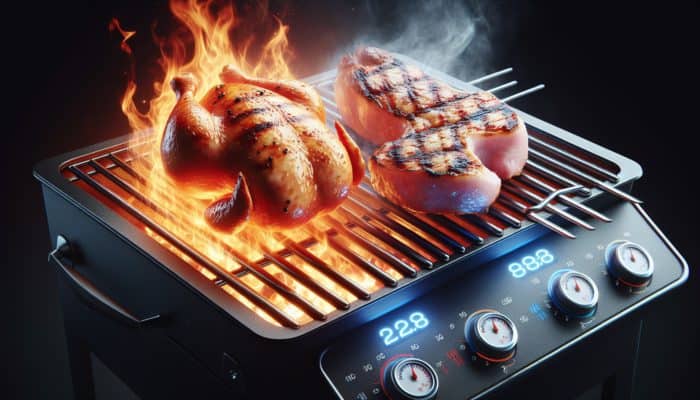Unlock the Full Potential of Your BBQ Grill with Proven Preparation Techniques
Implement Essential Cleaning and Maintenance Techniques for Peak Grill Performance

Achieving remarkable cooking results and elevating your BBQ experience starts with a thoroughly cleaned and well-maintained grill. Regular cleaning is not only a necessary chore; it is vital for ensuring optimal performance and enhancing the flavours of your grilled dishes. Begin the cleaning process by using a wire brush to meticulously scrub the grates, ensuring that all remnants and residues from previous grilling sessions are completely eliminated. After this initial scrubbing, it is highly recommended to wipe down the grates with a paper towel soaked in cooking oil. This crucial step prevents food from sticking to the grates while subtly enhancing the flavours of your upcoming BBQ. Furthermore, do not neglect the essential task of inspecting burners for any blockages. Clearing these obstructions is essential for achieving even heat distribution, which is critical for cooking your food perfectly.
Additionally, it is crucial to regularly inspect hoses and connections for any signs of leaks or wear. A simple mixture of soap and water can be used to detect leaks, as bubbles will form at the site of any leaks indicating a problem. Regularly replacing components that show signs of deterioration is necessary for safety, and always ensure that your grill is covered when not in use to protect it from the elements. This fundamental maintenance routine not only extends the lifespan of your grill but also enhances safety, allowing you to focus on creating delicious meals without the concern of mechanical failures.
Selecting the Perfect Fuel Type for an Outstanding BBQ Experience
When it comes to choosing a fuel source for your BBQ, it is essential to consider your flavour preferences, as well as the convenience each option offers. Charcoal, gas, and electric grills provide distinct benefits that cater to various grilling styles and needs. Charcoal grills are highly regarded for their ability to impart a rich smoky flavour to your food, delivering that classic BBQ taste that many enthusiasts crave. However, it is important to note that charcoal requires more time to reach cooking temperatures and can pose challenges in managing temperature effectively.
On the other hand, gas grills provide easy temperature control and quick ignition times, making them ideal for individuals who value convenience and speed in their cooking processes. With just a simple twist of a knob, you can achieve consistent temperatures, making gas grills perfect for busy gatherings where timing is crucial. For those living in areas with restrictions on open flames, electric grills offer a practical alternative. They are easier to maintain and clean, although they might lack the depth of flavour that is typically associated with charcoal grilling.
Setting Up Your Grill for Effective Direct and Indirect Heat Cooking Techniques
Understanding how to effectively set up your grill for different cooking methods is a critical skill for mastering BBQ techniques. Direct heat cooking involves placing food directly over the heat source, making it ideal for quick-cooking items such as steaks, burgers, and hot dogs. When utilizing direct heat, ensure that your grill is preheated to a high temperature to achieve a delectable sear on the outside while maintaining juiciness on the inside.
Conversely, indirect heat involves positioning food away from the flames, allowing for slower, more even cooking. This technique is particularly well-suited for larger cuts of meat, such as ribs or whole chickens, where the goal is to achieve tenderness without burning the exterior. To set up for indirect heat, light one side of the grill while leaving the opposite side unlit, creating a controlled cooking environment. Mastering both direct and indirect heat techniques will undoubtedly elevate your summer BBQ feast to new heights of culinary excellence.
Proven Techniques for Creating a Memorable Summer BBQ Feast

Choosing the Best Cuts of Meat for BBQ Success
Selecting the right cuts of meat is a pivotal factor in achieving BBQ success. The quality and type of meat you choose can profoundly affect the overall flavour and texture of your dishes. Here is a curated list of prime cuts that are ideal for BBQ:
- Ribeye
- Brisket
- Pork shoulder
- Chicken thighs
- Tri-tip
- Baby back ribs
- Lamb chops
- Whole fish
When selecting meat, pay close attention to the marbling, which refers to the distribution of fat within the cut. Cuts with excellent marbling, such as ribeye, are often more tender and flavourful when grilled. While brisket may be tougher, it is perfect for low and slow cooking methods that allow the connective tissues to break down, infusing the meat with incredible flavours. Pork shoulder is another outstanding choice, especially for BBQ pulled pork, which can be savoured in sandwiches or enjoyed on its own. Additionally, consider the cooking technique you plan to employ, as certain cuts are better suited for specific methods than others.
Boosting Flavours with Marinades and Rubs
To enhance the taste of your BBQ meats, consider incorporating marinades and rubs into your preparation routine. The fundamental components of effective marinades typically consist of a mixture of acids, such as vinegar or citrus juice, combined with herbs, spices, and a hint of oil. These ingredients work synergistically to tenderize the meat while infusing it with bold, delicious flavours. For example, a simple marinade crafted from olive oil, lemon juice, garlic, and rosemary can work wonders on chicken or lamb.
Dry rubs also serve as an excellent method to enhance the depth of flavour in your meats without adding extra moisture. A blend of brown sugar, paprika, garlic powder, and cumin can create a delightful crust on ribs or steak. Don’t hesitate to experiment with various combinations to discover your preferred flavours. Remember to marinate or rub your meats well in advance of cooking to allow the flavours to penetrate deeply. This preparation not only enhances taste but guarantees a more satisfying BBQ experience overall.
Mastering Timing and Temperature Control for Perfectly Cooked Meats

Monitoring and adjusting grill temperatures is crucial for achieving perfectly cooked meats. Utilizing a reliable digital thermometer is one of the most effective ways to ensure your food reaches the appropriate internal temperature for both safety and flavour. For instance, chicken must be cooked to an internal temperature of 75°C (165°F) to eliminate any risk of foodborne illnesses, while pork should reach at least 63°C (145°F).
When grilling, always keep in mind that the cooking process continues even after you remove the meat from the grill. Carryover cooking can raise the internal temperature by up to 5°C (10°F), making it essential to plan accordingly. Allowing your meat to rest after cooking not only enhances its juiciness but also allows the flavours to settle properly. Incorporate this timing into your BBQ strategy, and you will consistently produce exceptional dishes that impress your guests.
Irresistible Side Dishes to Complement Your BBQ Meal
Essential Classic Salads for Your BBQ Feast
No BBQ gathering is complete without a selection of classic salads that perfectly complement the main course. Essential salads include potato salad, coleslaw, and seasonal green salads, each providing a refreshing contrast to the rich, smoky flavours of grilled meats. A creamy potato salad, with its tangy dressing and hearty potatoes, serves as a satisfying side that pairs beautifully with BBQ items.
Coleslaw adds a crunchy, cool texture that helps balance the meal. A simple blend of shredded cabbage, carrots, and a tangy vinaigrette is all that’s needed to create this dish. For those seeking lighter options, consider a seasonal green salad. Incorporating fresh ingredients such as cherry tomatoes, cucumbers, and herbs can create a vibrant dish that adds colour and nutrition to your feast. For added texture and flavour, think about garnishing your salads with nuts or seeds, enhancing their overall appeal.
Why Grilled Vegetables Are a Delicious and Nutritious Addition
Grilled vegetables are not just a healthy addition; they also introduce a visually appealing component to your meal. Certain vegetables, like peppers, zucchini, and corn, grill exceptionally well. When grilling, ensure that you cut them into uniform pieces to guarantee consistent cooking. A light seasoning of salt, pepper, and a drizzle of olive oil can elevate their natural flavours, making them utterly irresistible.
Grilling vegetables not only enhances their sweetness but also imparts a charred flavour that beautifully complements your meats. Incorporate a variety of colours and textures to create a stunning platter that encourages guests to indulge in healthy options. For an extra twist, consider marinating your vegetables in similar marinades used for meats, allowing the flavours to meld together and create a cohesive meal experience that delights the palate.
Choosing the Perfect Breads and Buns to Elevate Your BBQ Experience
Selecting the right breads and buns can significantly enhance your BBQ experience. Options such as brioche buns, ciabatta, and homemade cornbread serve as excellent companions for your grilled meats. Brioche buns provide a soft, slightly sweet base for burgers, enhancing both flavour and texture. Ciabatta, with its crisp crust and airy interior, is ideal for sandwiches filled with pulled meats and fresh toppings.
If you’re feeling adventurous, consider making cornbread. This Southern classic is not only easy to prepare but also offers a delightful sweetness that pairs beautifully with barbecue dishes. Offering a variety of breads caters to diverse preferences, ensuring everyone finds something they enjoy. Don’t forget to provide butter and accompaniments like garlic aioli or fresh herbs to further enhance the flavours of your grilled feast.
Crafting the Ultimate BBQ Sauce: Step-by-Step Guide
Homemade vs. Store-Bought BBQ Sauce: Making the Right Choice
When it comes to BBQ sauce, both homemade and store-bought options come with their own unique advantages and disadvantages. Homemade BBQ sauce allows for a high degree of customisation, enabling you to adjust flavours and ingredients according to your personal preferences. You can experiment with various bases, including tomato, mustard, or vinegar, while controlling the sweetness and spice levels to suit your taste.
Conversely, store-bought BBQ sauces offer convenience and consistency, saving precious time for those who prefer to focus on grilling rather than sauce preparation. Many brands provide an extensive range of flavours and styles, making it easy to find something that appeals to your palate. For those just starting their BBQ journey, store-bought options can be a fantastic way to ensure mouthwatering results without the hassle of crafting homemade sauces. Ultimately, the decision depends on your personal preferences and the amount of time you have available for preparation.
How to Achieve the Perfect Sweet, Spicy, and Tangy Balance in BBQ Sauce
The ideal BBQ sauce achieves a harmonious balance between sweet, spicy, and tangy flavours. Key ingredients contributing to this balance include sugar, vinegar, and spices. Brown sugar or honey can provide the necessary sweetness, while apple cider vinegar or lemon juice introduces a tangy kick. To achieve your desired level of heat, consider incorporating cayenne pepper, hot sauce, or even smoked paprika for a unique twist that excites the palate.
When crafting your own BBQ sauce, it is essential to taste as you go. This practice helps you find the perfect balance that complements your grilled meats without overwhelming them. Remember that different meats may pair better with specific flavours; for instance, a sweet sauce may work beautifully with pork, while a tangy sauce typically complements chicken. Experimentation is key, so don’t hesitate to adjust the ingredients until you achieve your desired flavour profile.
Application Techniques for Maximum Impact of BBQ Sauce
Applying BBQ sauce at the appropriate time during cooking is critical for maximizing flavour. Brush the sauce onto your meats towards the end of the grilling process to prevent it from burning. The sugars present in most sauces can caramelise quickly, resulting in a burnt exterior if applied too early in the cooking timeline.
Consider using a basting brush to apply the sauce evenly, ensuring that each bite is packed with flavour. If you’re grilling various types of meat, think about designating a specific area on the grill for applying sauce; this will help avoid cross-contamination. Additionally, serve extra sauce on the side for guests who enjoy a little more heat with their meal. This approach allows everyone to savour the flavours they love without compromising the integrity of your BBQ dishes.
Incorporating Unique Ingredients into Your BBQ Sauce for a Twist
Incorporating unconventional elements into your BBQ sauce can surprise and delight your guests. Ingredients such as coffee, chocolate, or fruit can introduce unexpected depth and complexity to your sauce. For instance, a splash of coffee can enhance the richness of a tomato-based sauce, while a dash of cocoa powder can add a subtle bitterness that beautifully balances sweetness.
Fruits like peaches or pineapples can provide delightful sweetness and acidity, creating a refreshing twist on traditional BBQ sauces. Consider crafting a mango BBQ sauce that combines ripe mangoes, ginger, and lime for a tropical flair. The key is to start with a base recipe and gradually incorporate these unique elements, tasting as you go to create an enticing fusion of flavours. Your guests will appreciate the creativity and may even ask for the recipe to try at home!
Best Practices for Storing and Preserving Your BBQ Sauce
Proper storage of your homemade BBQ sauce is essential for maintaining its freshness and flavour. To ensure longevity, consider refrigerating your sauce in an airtight container, which can typically extend its shelf life to several weeks. Ensure the container is clean and dry before pouring in the sauce to avoid contamination.
If you wish to store BBQ sauce for an extended period, canning presents an excellent option. This process involves sterilizing jars and sealing them to create a vacuum, preserving the sauce for months. Always label your jars with the date and contents to easily keep track of what you have on hand. Whether refrigerating or canning, taking these steps will ensure you have delicious BBQ sauce ready for your future culinary adventures.
Implementing Essential BBQ Safety and Hygiene Practices
Ensuring Food Safety and Keeping Your BBQ Guests Healthy
Maintaining food safety during your BBQ is crucial for safeguarding your guests’ health and well-being. Adhere to proper food handling and storage techniques to prevent foodborne illnesses. Always keep raw meats separate from other foods, using dedicated cutting boards and utensils to avoid cross-contamination. It is essential to wash your hands thoroughly after handling raw meat to prevent the spread of harmful bacteria.
Be sure to cook meats to the correct internal temperatures using a reliable meat thermometer. For example, ground meats should reach at least 70°C (160°F), while poultry needs to hit 75°C (165°F). Additionally, serve food promptly and avoid leaving cooked items out at room temperature for extended periods. Serve side dishes chilled and keep hot foods at the appropriate temperature to maintain food safety throughout your BBQ event. By adhering to these guidelines, you can enjoy a worry-free BBQ experience.
Grill Safety: Preventing Accidents and Injuries
Grill safety is paramount for preventing accidents and injuries during your BBQ. First and foremost, keep a fire extinguisher nearby and ensure that everyone knows how to use it. When grilling, wear appropriate clothing—avoid loose-fitting garments that could catch fire or become caught in the grill. Always position the grill in a well-ventilated area, away from overhanging branches or structures that could pose a fire hazard.
Never leave the grill unattended, especially when it’s lit. If you must step away, ask someone to supervise it. If your grill is gas-powered, regularly check connections for leaks, and always light it according to the manufacturer’s instructions. Implementing these safety measures ensures a fun and relaxed atmosphere for all your BBQ guests.
Efficient Clean-Up Procedures and Waste Management Strategies
Efficient clean-up and waste management are vital for maintaining a safe and enjoyable BBQ environment. After cooking, allow the grill to cool down before cleaning it. Once it’s at a safe temperature, use a wire brush to remove any food residue and grease from the grates. Properly dispose of any leftover food and packaging, separating recyclables from regular trash to support eco-friendly practices.
Consider using biodegradable cleaning products to minimize environmental impact while keeping your grill in excellent condition. Set up designated waste and recycling bins at your BBQ to encourage guests to dispose of items properly. A clean and organized BBQ area not only promotes safety but also enhances the overall enjoyment of the event, allowing everyone to focus on great food and wonderful company.
Research-Backed Advantages of Cooking a Summer BBQ Feast
Exploring the Nutritional Benefits of Grilled Foods
Grilling is not merely a delicious cooking method; it also offers several nutritional benefits. One of the primary advantages of grilling is that it reduces the need for added fats and oils, making it a healthier option compared to frying or sautéing. Lean meats cooked on a grill maintain their natural flavours, and the high temperatures help seal in moisture, resulting in tender and juicy dishes that are both satisfying and nutritious.
Grilling vegetables preserves their nutrients, ensuring you receive the maximum health benefits from your meal. The quick cooking process allows vegetables to retain their vitamins and minerals, making grilled vegetables a nutritious addition to any BBQ feast. By incorporating a variety of grilled foods into your diet, you can enjoy meals that are not only flavourful but also promote a healthy, balanced lifestyle.
The Social and Psychological Benefits of BBQ Gatherings
Hosting a BBQ is not solely about the food; it also fosters community and strengthens social connections. Gatherings centred around food encourage relationships among friends and family, creating lasting memories and enhancing interpersonal bonds. The relaxed atmosphere of a BBQ allows people to unwind and enjoy each other’s company, contributing positively to mental health and overall well-being.
Moreover, the act of cooking together can serve as a bonding experience. Involving guests in food preparation or inviting them to share their favourite BBQ recipes can spark conversations and laughter, enhancing the enjoyment of the event. Ultimately, BBQs serve as a celebration of togetherness, relaxation, and joy, demonstrating that great food is best enjoyed in good company.
Understanding the Environmental Impact of Grilling Techniques
As awareness of environmental issues continues to grow, many BBQ enthusiasts are exploring eco-friendly grilling practices. Utilizing sustainable fuels, such as hardwood charcoal or propane, can significantly reduce the environmental footprint of your BBQ. These options produce less smoke and emissions compared to traditional grilling methods, making them a better choice for the planet.
Minimizing waste is another effective strategy to lessen your BBQ’s impact on the environment. Opt for reusable plates and utensils, and encourage guests to bring their own containers for leftovers. Composting food scraps and using eco-friendly cleaning products further contribute to sustainable practices. By adopting these strategies, you can enjoy a delicious BBQ while being mindful of the planet and its resources.
Essential BBQ Cooking Techniques to Master for Culinary Excellence
Mastering Direct Grilling: Quick Cooking at High Temperatures
Mastering the art of direct grilling is essential for quickly cooking foods like burgers and hot dogs. This technique involves cooking food directly over the heat source, allowing for a rapid sear that enhances flavours through caramelization. Keep the grill lid open to closely monitor the cooking process, ensuring that your food doesn’t overcook and remains juicy.
For optimal results, preheat the grill to a high temperature, typically around 200-230°C (400-450°F). This level of heat provides that satisfying char on the outside while keeping the inside moist. Remember to turn your food midway through cooking to achieve even browning and prevent sticking. Direct grilling is ideal for smaller cuts of meat and vegetables, enabling you to whip up a meal in no time.
Perfecting Indirect Grilling: A Slow and Low Cooking Method
Indirect grilling is a fantastic method for cooking larger cuts of meat that require more time to develop tenderness and flavour. This technique involves positioning the food away from the flame, allowing it to cook slowly and evenly. Perfect for items like ribs and roasts, indirect grilling creates juicy results without the risk of burning.
To set up your grill for indirect grilling, ignite one side while keeping the other side unlit. This arrangement creates a controlled cooking environment where heat circulates around the food. Maintain a temperature of about 120-150°C (250-300°F) for slow cooking. This method not only enhances flavours but also allows for the perfect caramelization of sauces and rubs, resulting in an unforgettable BBQ experience.
Infusing Deep Flavours with Smoking Techniques
Smoking on a BBQ grill is an art form that adds incredible depth of flavour to your meats. This method requires the use of wood chips or chunks, which can be soaked in water before grilling to create a steady release of smoke. Choose wood types based on your flavour preference—hickory and mesquite offer strong, bold flavours, while apple and cherry woods provide a milder, fruity aroma that enhances the overall taste experience.
Maintain a low temperature, ideally between 90-120°C (200-250°F), for optimal smoking results. This low and slow approach allows the smoke to penetrate the meat, infusing it with rich flavours that will impress your guests. Keep the grill covered as much as possible to maintain smoke and heat, and use a thermometer to monitor the internal temperature of your meat. Smoking can transform a standard BBQ into a gourmet experience that truly elevates your culinary skills.
Reverse Searing: The Secret to Cooking Perfect Steaks
Reverse searing is a technique that simplifies the process of achieving perfectly cooked steaks. This method involves cooking steaks at a low temperature first, ensuring they cook evenly throughout. Start by preheating your grill to a low setting, around 120-130°C (250-275°F), and place your steaks on the grill away from direct heat.
Once they have reached an internal temperature of about 50-55°C (120-130°F), remove them from the grill and allow them to rest for a few minutes. Then, increase the grill’s temperature to high and sear the steaks on both sides for 1-2 minutes to create a delicious crust. This technique guarantees that your steaks are tender and juicy, providing a flavourful exterior that will impress any guest. It’s a reliable method to achieve restaurant-quality results right in your own backyard.
Indulging in BBQ Desserts: Sweet Endings to Your Feast
How to Prepare Grilled Fruit: Simple and Delicious Dessert Ideas
Grilled fruit is a delightful and unexpected addition to your BBQ dessert offerings. Certain fruits, such as pineapples, peaches, and bananas, caramelize beautifully when grilled. To prepare, cut them into thick slices or halves and lightly brush them with oil to prevent sticking. Place them on the grill over medium heat, allowing them to cook for a few minutes on each side until they develop those signature grill marks.
The grilling process enhances the natural sugars in the fruit, creating a warm, sweet treat that pairs wonderfully with ice cream or yogurt. Consider sprinkling a touch of cinnamon or drizzling honey over the grilled fruit for an added flavour boost. Grilled fruit not only provides a refreshing end to your meal but also adds an elegant touch to your BBQ dessert spread, making it a memorable experience for all.
Crafting S’mores and Other Campfire Delights
For a fun and nostalgic BBQ dessert, consider making s’mores. This classic treat involves roasting marshmallows over an open flame before sandwiching them between graham crackers and chocolate. The combination of warm, gooey marshmallows and melted chocolate is truly irresistible. Alternatively, you can experiment with variations such as using chocolate-covered cookies or adding peanut butter for an exciting twist.
In addition to s’mores, grilled doughnuts also make for a delightful dessert option. Slice doughnuts in half and grill them for a couple of minutes until warm and slightly crispy. Serve them with fresh fruit or ice cream for a scrumptious conclusion to your BBQ meal. These easy, interactive desserts will surely entertain and satisfy your guests’ sweet cravings, ensuring a memorable end to your feast.
Pairing Desserts with Ice Cream and Other Frozen Treats
Pairing your grilled desserts with cool treats is an excellent way to create a refreshing conclusion to your BBQ feast. Ice cream or sorbet can effectively balance the warmth of grilled fruits, providing a delightful contrast in temperature and taste. Consider setting up an ice cream station where guests can customize their own sundaes with a variety of toppings.
Frozen treats, such as popsicles made from pureed fruit or yogurt, also make a great option for dessert. These can be prepared ahead of time and offer a light, refreshing end to the meal. For an added twist, try pairing grilled fruit with a scoop of vanilla ice cream and a drizzle of caramel sauce for a decadent dessert that will leave your guests wanting more. This delicious combination will surely enhance your BBQ experience and create lasting memories.
Strategizing and Hosting Your BBQ Event for Maximum Enjoyment
Creating a BBQ Menu with Variety and Balance
Planning a BBQ menu that caters to diverse tastes and dietary needs is essential for ensuring everyone enjoys the feast. Aim for a variety of meats, vegetarian options, sides, and desserts to create a well-rounded meal. Consider incorporating classic BBQ staples like burgers and sausages, along with grilled fish or plant-based alternatives like veggie burgers or skewers for those who prefer non-meat options.
Incorporate a selection of side dishes such as salads, grilled vegetables, and baked beans to complement your main courses. Additionally, don’t forget about dietary restrictions; offering gluten-free buns or vegan sides can make your BBQ inclusive for all guests. A thoughtfully planned menu not only enhances the overall experience but also showcases your skills as a host.
Creating the Ideal Atmosphere: Décor and Music Choices
Establishing the right atmosphere is key to an enjoyable BBQ gathering. Use outdoor lighting, such as string lights or lanterns, to add warmth and charm to your space. Comfortable seating arrangements are essential, encouraging guests to linger and enjoy each other’s company. Consider incorporating colourful tableware and centrepieces that reflect the summer theme, enhancing the visual appeal of your event.
Music also plays a vital role in setting the mood. Curate a playlist filled with summer tunes that encourage relaxation and dancing. Upbeat tracks create a lively environment, making the gathering even more enjoyable. By focusing on these aesthetic details, you can transform a simple BBQ into a memorable occasion that your guests will cherish long after the event.
Inviting Guests and Planning Engaging Activities
Planning engaging activities and games can keep your guests entertained throughout the BBQ. Lawn games like cornhole, giant Jenga, or frisbee create an inviting atmosphere for guests to mingle and interact. Consider hosting a BBQ cook-off where guests can showcase their cooking skills and compete for fun prizes. This adds an element of friendly competition and encourages participation from everyone, enhancing the overall enjoyment.
Invitations can also set the tone for your event. Use creative designs that reflect the BBQ theme, and consider incorporating RSVP options to gauge the number of guests beforehand. This helps with planning food quantities and seating arrangements. By creating a dynamic environment filled with activities and thoughtful touches, you can ensure your BBQ is a resounding success with all attendees.
Frequently Asked Questions About BBQ Practices
What is the most effective method for cleaning my BBQ grill?
The most effective way to clean your BBQ grill is to use a wire brush to scrub the grates while they are still warm. This technique helps remove any residue and ensures a clean cooking surface for your next use.
How long should I marinate meat before BBQ cooking?
Marinating meat for at least 30 minutes is recommended, but for optimal flavour, aim for 2 to 12 hours, depending on the type of meat and the marinade ingredients used.
What temperature should I aim for when cooking chicken on the BBQ?
Chicken should be cooked to an internal temperature of at least 75°C (165°F) to ensure it is safe to eat and remains juicy throughout.
Can I BBQ vegetables without using oil?
Yes, you can BBQ vegetables without oil; however, using a light brush of oil enhances flavour and helps prevent sticking to the grill.
How can I prevent my BBQ sauce from burning during cooking?
To prevent BBQ sauce from burning, apply it towards the end of the cooking process. This allows for flavour enhancement without the risk of caramelisation and burning.
What are some great vegetarian BBQ options to consider?
Good vegetarian BBQ options include veggie burgers, grilled portobello mushrooms, vegetable skewers, and grilled corn on the cob, all of which are hearty and satisfying alternatives.
How can I tell when my steak is done cooking?
The best way to know if a steak is done is to use a meat thermometer. For medium-rare, target an internal temperature of 55°C (130°F) and for medium, 60°C (140°F).
Is it safe to use the same utensils for raw and cooked meat?
No, it is not safe to use the same utensils for raw and cooked meat, as this can lead to cross-contamination and foodborne illnesses. Always use separate utensils for each.
What should I serve with BBQ ribs for the best experience?
BBQ ribs pair beautifully with classic sides like coleslaw, baked beans, cornbread, and grilled corn. These sides complement the rich flavours of the ribs perfectly.
Can I grill desserts on the BBQ for a sweet treat?
Yes, you can grill desserts on the BBQ! Grilled fruits, s’mores, and even grilled doughnuts make for delightful sweet endings to your BBQ feast.
Connect with us on Facebook for the latest updates!
The post How to Cook a Summer BBQ Feast: A Universal Guide appeared first on https://cookinggods.com
The Article Summer BBQ Feast: Your Ultimate Cooking Guide Was Found On https://limitsofstrategy.com
The Article Summer BBQ Feast: The Ultimate Guide to Outdoor Cooking First Appeared ON
: https://ad4sc.com










No responses yet